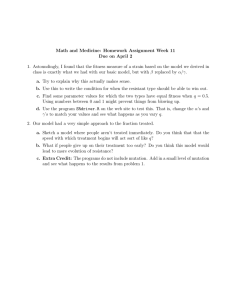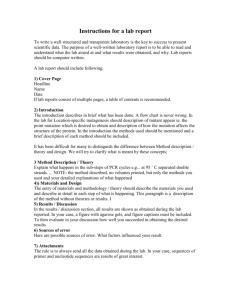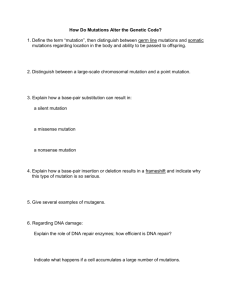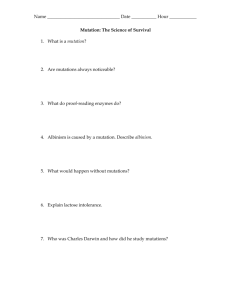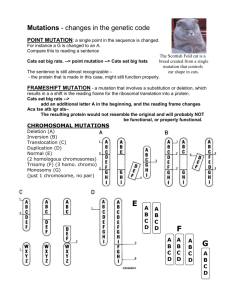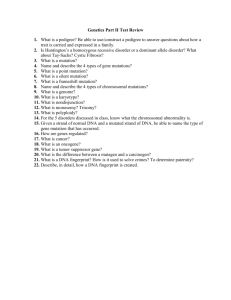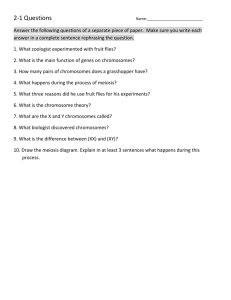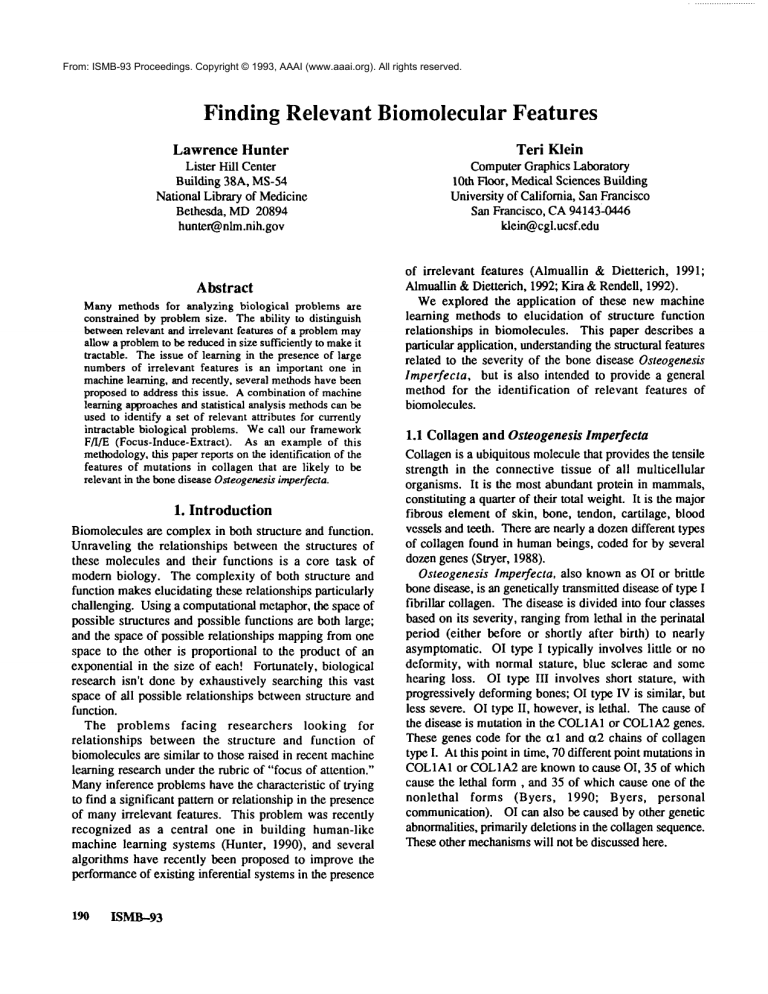
From: ISMB-93 Proceedings. Copyright © 1993, AAAI (www.aaai.org). All rights reserved.
Finding Relevant Biomolecular Features
Lawrence Hunter
Lister Hill Center
Building 38A, MS-54
National Library of Medicine
Bethesda, MD20894
hunter@nlm.nih.gov
Abstract
Manymethods for analyzing biological problems are
constrained by problemsize. The ability to distinguish
betweenrelevant and irrelevant features of a problemmay
allowa problemto be reducedin size sufficiendyto makeit
tractable. Theissue of learning in the presenceof large
numbersof irrelevant features is an important one in
machinelearning, and recently, several methodshavebeen
proposedto address this issue. A combinationof machine
learning approachesand statistical analysis methodscan be
used to identify a set of relevant attributes for currently
intractable biological problems. Wecall our framework
F/I/E (Focus-Induce-Extract). As an exampleof this
methodology,
this paperreports on the identification of the
features of mutations in collagen that are likely to be
relevant in the bonedisease Osteogenesis
imperfecta.
1. Introduction
Biomoleculesare complexin both structure and function.
Unraveling the relationships between the structures of
these molecules and their functions is a core task of
modern biology. The complexity of both structure and
function makeselucidating these relationships particularly
challenging. Using a computational metaphor, the space of
possible structures and possible functions are both large;
and the space of possible relationships mappingfrom one
space to the other is proportional to the product of an
exponential in the size of each! Fortunately, biological
research isn’t done by exhaustively searching this vast
space of all possible relationships between structure and
function.
The problems facing researchers
looking for
relationships between the structure and function of
biomoleculesare similar to those raised in recent machine
learning research under the rubric of "focus of attention."
Manyinference problems have the characteristic of trying
to find a significant pattern or relationship in the presence
of manyirrelevant features. This problem was recently
recognized as a central one in building human-like
machine learning systems (Hunter, 1990), and several
algorithms have recently been proposed to improve the
performanceof existing inferential systems in the presence
190 ISMB--93
Teri Klein
ComputerGraphics Laboratory
10th Floor, MedicalSciences Building
University of California, San Francisco
San Francisco, CA94143-0446
klein@cgl.ucsf.edu
of irrelevant features (Almuallin & Dietterich, 1991;
AlmuaUin& Dietterich, 1992; Kira & Rendell, 1992).
Weexplored the application of these new machine
learning methods to elucidation of structure function
relationships in biomolecules. This paper describes a
particular application, understandingthe structural features
related to the severity of the bone disease Osteogenesis
Imperfecta, but is also intended to provide a general
method for the identification of relevant features of
biomolecules.
1.1 Collagen and Osteogenesis lmperfecta
Collagenis a ubiquitous moleculethat provides the tensile
strength in the connective tissue of all multicellular
organisms. It is the most abundant protein in mammals,
constituting a quarter of their total weight. It is the major
fibrous element of skin, bone, tendon, cartilage, blood
vessels and teeth. There are nearly a dozendifferent types
of collagen found in humanbeings, coded for by several
dozen genes (Stryer, 1988).
Osteogenesis lmperfecta, also knownas OI or brittle
bonedisease, is an genetically transmitted disease of type I
fibrillar collagen. Thedisease is divided into four classes
based on its severity, ranging from lethal in the perinatal
period (either before or shortly after birth) to nearly
asymptomatic. OI type I typically involves little or no
deformity, with normal stature, blue sclerae and some
hearing loss. OI type III involves short stature, with
progressively deformingbones; OI type IV is similar, but
less severe. OI type II, however,is lethal. The cause of
the disease is mutation in the COL1A1
or COL1A2
genes.
These genes code for the t~l and ¢t2 chains of collagen
type I. At this point in time, 70 different point mutationsin
COL1A1or COL1A2
are known to cause OI, 35 of which
cause the lethal form, and 35 of which cause one of the
nonlethal forms (Byers, 1990; Byers, personal
communication). OI can also be caused by other genetic
abnormalities, primarily deletions in the collagen sequence.
These other mechanismswill not be discussed here.
(A)
(B)
Figure 1: A model of the structure of collagen. This modelis derrived by substituting the actual side chains of a 10
residue long region (from 823-832 of the a 1 chain) into the crystal structure of a [GLY-PRO-PRO]
10 polymer and
minimizingthe energy of the resulting structure. (A) showsa space-filling modelof the region; glycine residues form the
central core of the chain. (B) showsa ribbon modelof the Ca backbone,with glycines depicted in black; this modelclearly
shows the triple helix. Graphics generated by the UCSFMIDAS
program.
Manyaspects of the structure of the collagen molecule
are known. The molecule is one of the longest known
proteins, nearly 3000Along and about 15Ain diameter.
Type I collagen consist of two copies of the ¢tl chain and
one strand of the a2 chain, woundaround each other to
form a structure that includes a very strong triple helix.
Collagen is unusual in several respects. It contains two
amino acids that are found in almost no other proteins:
hydroxyproline and hydroxylysine. The hydroxylafion of
the proline and lysine residues occurs as a posttranslational
modification of the protein, and only occurs at residues on
the aminoside of a glycine. /mother striking feature of the
moleculeis its unusual periodic sequence: glycine is nearly
every third residue, and the sequence glycine-prolinehydroxyproline occurs repeatedly. Collagen is also unlike
most other proteins in that it has an essentially linear
conformation, and there are no structural interactions
betweenaminoacids that are distant in the sequence. This
is very important since it drastically reduces the numberof
features that must be considered. Figure 1 portrays some
of the importantfeatures of type I collagen.
Despite the knowledgeof the structure of the molecule,
and the ability to identify mutationsthat are both lethal and
nonlethal, the precise relationship betweenthe features of a
mutation and whether or not it will be lethal remains
obscure. For example, there are several mutations to a
particular aminoacid (e.g. from glycine to serine) that are
lethal in one location, and nonlethal in another. This
problem of understanding the relationship between a
mutation and its phenotype is a common
subtask of finding
structure/function relationships. The application goal of
this paper is to use machinelearning methodsto discover
the factors that influence whethera collagen mutation will
be lethal or not.
1.2 Finding Relevant Features
The first step in addressing an induction problem is
generally to define the space of features that will be used to
describe the examples. This task is challenging because it
is constrained by two competing forces. The first
constraint is the requirement to include all relevant
features. Any information about the objects to be
classified not included in the input features cannot be used
by any induction method. The competing constraint is the
need to keep the numberof features used to describe the
objects relatively small. There are two reasons for this
constraint.
First, the computational complexity of
induction algorithms generally scales poorly in the number
of features used to describe each object. If the algorithm
considers all possible combinationsof features, then its
running time is likely to grow exponentially in the number
of features to consider. Second, if there are a large
numberof features considered by the induction algorithm,
the probability that a feature or combinationof features
will correlate with the distinction being induced simply by
chanceincreases. That is, the possibility of overfitting the
data grows with the numberof features. This probability
Hunter
191
depends both on the numberof features and the numberof
examples, and is especially acute in problems with scarce
training data.
In our particular problem, as with manyothers, it is
impossible to depend on existing background knowledgeto
pick an appropriate sized collection of features to use for
induction. There are manypossibly relevant features of the
collagen molecule that might be involved in whether or not
a mutation is lethal. In order to investigate these
possibilities, previous workhas built simplified modelsof
local regions of collagen and used molecular dynamics to
explore the ramifications of particular mutations (Huang,et
al., 1991). The model used was based on a X-ray structure
of a sequence of ten repeats of the amino acid triple
glycine-proline-proline, substituting an actual collagen
sequence. A single glycine mutation (to aspartic acid) was
explored by energy minimization techniques and molecular
dynamics. Although this simulation showed the mutation
caused disruptions of the helix, the method is too
computationally intensive to be able to build a detailed
understanding of the structure/function
relationship
without morespecific direction.
The next step was an attempt at manual discernment of
patterns in the collagen sequence around the mutations.
Patterns involving the basic biophysical features of charge
and hydrophobicity were generated by domain experts and
tested on the known mutations. None of these expertgenerated patterns
were adequate for reliable
discrimination of lethal mutations, and the space of
possible patterns was recognized to be enormous. For
example,note that (Byers, 1990) proposes that the lethality
of a mutation is determined by how near it is to the
carboxyterminus, and that the extent of this critical region
mayhe determined by the substituting aminoacid. In the
intervening three years, the number of knownmutations
has almost doubled, and our results suggest this hypothesis
is no longer supported.
The advent of machinelearning methodsthat can handle
large numbersof irrelevant features, it has becomepossible
to meaningfullysearch the entire large space of patterns.
The remainder of this paper describes the application of a
novel combination of machine learning techniques to the
problem.
stages: first, identify all possibly relevant features, without
regard to the problems of efficiency or overfitting in
induction. Second apply an focused induction method
designed to handle large numbersof irrelevant features.
The induction must take place in a frameworkthat allows
the measurementof the statistical
significance of the
results. It is whenthe results of induction are statistically
significant in the aggregate, but do not contain enough
information to generate a single set of reliable rules or
decision tree that our methodis useful. In that case, we
decomposethe results of the induction to identify the
features most likely to be involved in the target
relationship.
2. Methods
1 Thiscritical regionis definedbya statistically significant
increase in the numberof lethal mutationsfound.Althoughmany
nonlethalmutationsare also foundin this region, the numberof
lethal mutationsfoundthere is greater than the number
than
wouldbe expectedif the mutationsweredistributed at random,
at
the p<.05level. Countingfromthe aminoterminus,this region
beginsat residue950and continuesto the carboxyend of the
chain. Thereis no corresponding
region wherethere is a greater
that expectednumberof nonlethalmutations.
For each mutation, we know which amino acid was
substituted in the mutation, wherethe mutation occtLrred in
the sequence (including whichchain) and whether or not
was lethal (see Table 1, next page). For each of these
mutation locations, we can easily deduce a large numberof
features of its environment.
Wepropose a Focus-Induce-Extract (F/I/E) method for
identifying relevant features. The process involves three
192
ISMB-93
2.1 The Universe of Possibly Relevant Features
Since the structure of collagen is a linear helix, amino
acids far awayfrom the mutation in the sequence will also
be far awayin the structure. In identifying features of the
molecular environment, we need only consider the aspects
of the aminoacids that are nearby in the collagen sequence,
or in the corresponding region on the other chain. The
distances at whichbiochemical forces are effective limits
the region of interest to about two turns of the helix in
either direction,
or about 7 amino acids. To be
conservative, we defined the local neighborhoodto include
three turns of helix (10 aminoacids) in either direction
from the mutation, on both chains, a total of 42 amino
acids. For each of these amino acids, we consider five
biochemical features: which amino acid it is, the
hydrophobicity, molecular weight, charge and pK(that is,
the pHat whichthe residue becomescharged, if it becomes
charged at all; this is set to -1 if it does not become
charged). Hydrophobicitywas taken from (Cornette, et al.,
1987), table 4 (the PRIFTscale) and the other biophysical
constants were taken from (Schulz & Schirmer, 1979),
table 1-1. In addition, a feature indicating whether the
position wouldbe off the end of the chain is noted for each
neighbor, and there are three global features for each
mutation: which chain it occurred in, the position in the
chain (counting from the aminoterminus), and whether
is in a proposed critical region, the 60 residues at the
carboxy terminus of the chain. 1 So, for each mutation,
there are 6*42+3or 258 features. Most of these features
Ol Type II (Lethal)
Ala: 928al
Set. 565al, 598al, 631al, 913al, 964al, lO03al, lO09al, 865a2
Cys: 244al, 472al, 691ai, 718ai, 748ai, 904ai, 988ai, 4720.2, 787ot2
Arg: 298otl, 391al, 55000, 667al, 847al, 976al, 49602, 69400.
Val: 256~1,.637al, 973al, lO06al
Asp: 97al, 541al, 559al, 673al, 883al
Table 1: The mutations in collagen that lead to OI. Each mutation is represented by a numberrepresenting a position in the
chain (counting from the aminoterminus) followed by either al or a2. The long strings at the bottom of the figure are the
sequences of the al and o.2 chains respectively, using standard aminoacid abbreviations, except for Z, whichhere stands for
hydroxyproline.
are numeric (position, hydrophobicity, molecular weight,
pK), and the remainder are nominal.
Recently, an explicit methodfor identifying potentially
relevant features given a labeled set of examples was
proposed as a way of improving the performance of
induction algorithms in the presence of manyirrelevant
features (Almuallin & Dietterich, 1991; Almuallin
Dietterich, 1992). However,this method, called FOCUS
is
both computationally inefficient, and performs poorly in
the presence of noise. (Kira & Rendell, 1992) propose
statistically based methodfor identifying probably relevant
features called RELIEF. This method has several
advantages over FOCUS:
It has linear time complexity in
the number of features it is considering (compared to
FOCUS’s,which can have time complexity O(2P) for
features, if all p turn out to be relevant). RELIEF
is also
effective in the presence9f 2noise (errors) in the data.
RELIEFgenerates relevance weights for each feature,
and requires as a parameter x that determines the cutoff
above which a feature will be considered relevant.
Although Kira and Rendell provide a method for
estimating this parameter, the method either requires
knowledgeof the distribution of the relevance levels for
each feature, or generates very large values for I:. They
also note that its usually possible to determine an
appropriate value for x by inspection. Someof the features
generated by the above exhaustive methodare knownto be
irrelevant. For example, the aminoacids +3, _+6 and _+9
from the mutation in the same chain should almost always
be glycine, and the features derived from those positions
should be irrelevant. The highest scoring of these features
2 Animplementationof RELIEF
in Common
Lisp is available
fromthe first author.
Hunter
193
had a relevance score of 0.071. Anotherway of estimating
the cutoff was to look for the lowest scoring feature we
though a priori was likely to be important. Welooked for
the lowest relevance score of an attribute of the mutation
itself, whichturned out to be its pKvalue, with a relevance
score of 0.204. Since there were 83 features at or above
the 0.2 level, and 127 features at or above the 0.07, we
decidedto use the stricter figure as the cutoff.
Oncethe set of potentially relevant features is selected,
they are used to generate decision trees using the C4.5
induction algorithm (Quinlan, 1986; Quinlan, 1987;
Quinlan, 1991). In order to evaluate the effectiveness of
the induction, it is embeddedin a k-way cross-validation
approach. The data is randomly divided into K
approximately equal sized subsets 3 . The induction
programis run K times; in each run, one of the subsets is
used as the test set, and the other K-1 subsets are combined
to form the training set. Each run produces a separate
decision tree. Each tree is tested on the appropriate test
subset. If the average performance of the collection of K
induced decision trees is significantly different from what
would be expected at random, than the induction method
is reliably finding a relationship betweenthe input features
and the predicted outcome.
There are several free parameters that must be set in
these runs. The "m" parameter of C4.5 sets a minimum
number of objects in each branch; since there were a
relatively small numberof examples, we incremented this
parameter from the default 2 to 3. Weused probabilistic
thresholds for continuousattributes (the "p" flag). For the
cross validation, we selected k=6 in order to give a
reasonable numberof instances in each test set (11 or 12).
The membersof a set of decision trees that performs above
the random level will not necessarily be identical. The
portions of the trees that are similar to each other are
presumably the source of the predictive accuracy of the
trees. (Redundancy among the input features, which
RELIEFdoes not detect, maybelie this assumption.) The
goal of the extract portion of the F/I/E methodis to find
the similarities amongthe induced trees.
Three methodsto extract similarities amongthe trees
were used. First, we looked for rules implied by more
than one decision tree. All decision trees can be
syntactically transformed into a set of rules. Such a set
contains a rule for each path fromthe root of the tree to a
leaf. The antecedentof each rule is the collection of values
implied by the decisions along the path, and the consequent
is the value at the leaf. Somepaths through a decision tree
mayhave little or no data supporting them, and can be
pruned away. The C4.Srules program uses this method to
extract rules. Weused the most stringent pruning method
3 Theparticular random
division can havean effect on the
outcome.Thedivision we usedis available fromthe authors.
194
ISMB-93
(the "-P3" flag), whichrequires that each antecedent in
potential rule pass a statistical significance test. After
generating rule sets for each of the K decision trees, we
identified rules that appeared in more than one tree. We
also manually searched for rules that were semantically
related variants of each other.
The second extraction methodidentified features that
appearedin multiple decision trees. For each input feature
(e.g. the hydrophobicityof the residue +2 of the mutation),
we counted the numberdecision trees in whichthat feature
appeared. For this calculation, if the prunedtree was more
accurate on the unseen data than the unpruned tree, a
feature was only counted if was in the pruned tree, since
presumablyfeatures the additional features in the unpruned
tree resulted in overfitting. This resulted in a list of
features that appearedin multiple trees.
The third methodfor exWactingsimilarities was to count
the numberof times any feature of a particular residue was
mentionedin a decision tree. For example, if the feature
"hydrophobicity of the residue +2 of the mutation"
appearedin one tree, and the feature "chargeof the residue
+2 of the mutation" appeared in another, the residue +2 of
the mutation wouldbe credited with appearing in two trees.
Although it is possible to count the number of common
rules or features in any set of decision trees, this aggregate
count is only possible because of the way the features
were generated for this experiment, and it mayor maynot
be possible to duplicate this extraction in other systems.
3. Results
Trees induced over the entire feature set (without using
RELIEF)were not statistically
different than random
guessing. However,using only the relevant features in the
instance descriptions resulted in a set of decision trees that
were statistically better than randomguessing at the p<.05
level. The average accuracy of the unpruned trees on
unseen test cases was 68.7% correct with a standard
deviation of 7.7%. The average performanceof the pruned
trees was 63.2% correct with a standard deviation of
12.7%, which is not statistically different from random
guessing. Using the best lrees from each run (4 prunedand
2 unpruned), the average accuracy is 69.2%with a standard
deviation of 7.0%, which is significantly different from
random.
So, in the aggregate, we can be reasonably certain that
C4.5 is finding decision trees that are capable of
generalizing to unseen data. However, the 6 trees
generated in the cross validation runs are quite different
from each other, and there is no statistically soundreason
to prefer any one of the trees over any other. It is perfectly
plausible that the tree that performedthe best on the unseen
data in these cross-validation runs was better than the tree
-2 of mutationis PRO
--~ lethal (3 trees)
Right: 21 (67%) Wrong: 10 (32%)
-2 of mutationis ALA
--> non-lethal (2 trees)
Right: 9 (75%) Wrong: 3 (25%)
+2 of mutation pK> 10.5 -~ lethal (2 trees, in 3ixt tree with threshold at 6)
Right: 6 (100%)Wrong: 0 (0%) with threshold at
Right: 8 (80%) Wrong: 2 (20%) with threshold
+4 of mutationchargenegative ---> lethal
Right: 10 (76%) Wrong: 3 (23%)
+4 of mutationcharge positive and +2 of mutationpK< 6 --> non-lethal
Right: 6 (100%) Wrong: 0 (0%)
Figure 2: The first three rules are extracted frommorethan one tree. The last pair of rules are related, but not identical; they
were extracted from one tree each. The correctness figures are taken over all training and test examples.
that had the worst performance strictly by chance. There
is too little data to treat anyone of these trees as reliable.
The fact that the induced decision trees are so different
from each other is an indication that there are still
problems with the data that prevent C4.5 from finding the
"true" decision tree. Wetried increasing the relevance
threshold x for RELIEF
to 0.3, but in that case C4.5 did not
find decision trees that were better than chance; we must
have eliminated sometruly relevant features by using that
high a threshold.
Wethen applied our extraction methods to the set of
statistically significant trees that we induced.Thefirst step
was to extract rules from each of the six induced trees in
the cross validation run, and look for rules that appearedin
multiple trees. The results of this extraction are shownin
Figure 2. Wethen examinedthe features that were used in
each of the trees. Each induction run produces both a
pruned and an unpruned tree. Pruning removes branches
of the tree, reducing complexity that may be a result of
overfilling. (This is a different kind of pruning than that
done in the rule generation step, above; see (Quinlan,
1987).) For each of the decision trees, selected the version
that had the best accuracy on the unseen data; four out of
six of these were the pruned versions. We made a
histogram of the number of times that each feature
appeared in a tree (Figure 3a, next page). The most
commonlyoccurringfeatures occurred in three of the six
trees; these three trees were also the best performingtrees
of the six (whichis at best mildly suggestive).
Wethen further aggregated this information to look for
which aminoacids were the subject of the features in the
decision trees. So, for example, any mention of the
hydrophobicity, charge, pK, etc. of the aminoacid -2 of the
mutation would get counted for that amino acid. One
aminoacid, the one +4 of the mutation, was mentionedin 5
out of 6 trees. Features of four other amino acids were
mentionedin at least three of the trees (see Figure 3b, next
page). Out of the 42 amino acids originally considered,
features from only 5 of them appear consistently in the
decision trees.
Wealso tested if the relevant features we found had
different distributions in the mutation data than they do in
the unmutated wildtype collagen. For every feature in
every tree, we found that the distribution of the feature
values for the wildtype and the mutation were statistically
indistinguishable; the distributions only became skewed
whencomparinglethal vs. non-lethal mutations (Figure 4,
last page).
4. Discussion
There are several biological surprises in these findings.
Most important, the position of the mutation in the chain
does not appear to be as relevant in determining its
lethality as previously believed. Position gets a fairly low
RELIEFscore, and does not showup in any of the decision
trees. Expert opinion had suggested that this was the main
determiningfeature of lethality (Byers, 1990). Wedid find
a statistically significant increase in lethality at the very
end of the ~t 1 chain, and there is a biophysical reason to
believe that the carboxy terminus is more sensitive to
mutations (it is where the triple helix begins to form).
However,our F/I/E results suggest that this is not the main
determining factor of lethality. Neither absolute position
of the mutation nor its proximity to the carboxy terminus
appears to be a good way to distinguish lethal from
nonlethal mutations. The hypothesis suggested by these
results is that the atomic environmentof the mutation is
the most importantfeature in determiningits lethality.
A second somewhatsurprising finding is the relatively
low importance of the mutation itself, compared to its
surrounding environment. These results clearly suggest
that the features of the aminoacids +2, +4 and +4 on the
opposite chain of the mutation are as important as the
mutation itself in determininglethality, or perhaps moreso.
Hunter
195
Appearedin three trees:
chain
+2 of mutation pK
-2 of mutation aminoacid
Appearedin two trees
mutation hydrophobicity
+4 of mutation charge
+4 of mutation hydrophobicity
+4 of mutationon opposite chain hydrophobicity
+4 of mutation on opposite chain pK
(A)
Features from this aminoacid appearedin five trees
+4 of mutation
Features from these aminoacids appeared in four trees
+2 of mutation
+4 of mutation on opposite chain
Features from these aminoacids appeared in three trees
-2 of mutation
mutationitself
03)
Figure 3: (A) The features that appeared in more than one tree. 03) The aminoacids whosefeatures appeared in three
more decision trees.
This is a possible explanation for the difficulty in
analyzing the modelused in (Huang,et al., 1991).
A third implication of this work is in suggesting the
ordering of the chains in the triple helix. There are two
topologically distinct orderings: the two ¢tl chains may
beadjacentto each other, or separated by the or2; that is, the
order could be ctl, ~tl, ct2 or ~tl, ct2, otl. The true
ordering is not currently known. Molecular models show
that the spatial neighborsacross the helix are position i, i+l
and i+2 respectively in the three chains. Making the
biophysically reasonable assumption that helical neighbors
are importantfactors in lethality, our finding that the amino
acids +2 from the mutation are relevant (and the amino
acids +1 are not) suggests that the chain orderingis ctl, 062,
¢tl. The reason is that in this case, the helix neighbors of
an aminoacid in one of the ~1 chains is the residue +2 of
that aminoacid in the other ctl chain. If the order were al,
ctl, or2, then the helix neighbor would be the +1 amino
acids, and presumably it wouldhave played a role in the
lethality predictions.
All of these implications must be considered tentative.
There is not enoughdata yet available to induce a reliable
decision tree or rule set for predicting the lethality of
unseen mutations. However,our findings maybe useful in
suggesting more realistic
models for analysis with
molecular dynamics and other powerful (but compute
intensive) tools, and in reducing the numberof simulations
196
ISMB-93
that need to be done. Our hypotheses also suggest
empirical work that could be done.
For the computational science community, the
significance of this workis primarily in the demonstration
that the F/I/E methodmakes it possible to productively
explore a large feature space with a relatively small amount
of data. There are a large number of problems, both in
elucidating structure function relationships and elsewhere
that can be reasonably cast in this framework. Although
we believe the analysis of the features used in induced
rules or decision trees is not uncommonamongmachine
learning researchers (although rarely published), we feel
that F/I/E’s combinationof RELIEF/C4.5
and this style of
post-induction feature analysis is clearly a novel approach.
F/I/E is also an exampleof the usefulness of the "planning
to learn" idea described in (Hunter, 1990), demonstrating
the benefits that combinations of multiple inference
methods can provide.
There are several limitations of this method. Most
important is the original selection of input features.
Althoughthe F/I/E methodallows for the consideration of
a large numberof features, it does not guarantee that the
correct features will be included in the original set. Of
course, if relevant features are omitted from the original
representation, the induction will likely fail. Also
important is keeping the amount of redundancy in the
feature set low. RELIEFis not capable of identifying
uncharged
negative
positive
wildtype
518 (76%)
109 (16%)
49 (8%)
mutation
48 (68%)
13 (19%)
9 (13%)
lethal mutation
23 (65%)
3 (9%)
9 (26%)
nonlethal mutation
25 (71%)
10 (34%)
0 (0%)
Figure 4: The distributions of the value of the feature +4 of mutation charge. The first row showsthe baseline dislribution
of the charge values of the residues +4 from the repeating glycines in unmutatedcollagen (all OI mutations occur in these
positions). The second row showsa very similar distribution holds over the residues +4 from actual mutations. However,
the last two rows showthat whenthe mutations are subdividedinto lethal and nonlethal, the distribution is quite skewed.
redundant features, and their presence interferes with the
effectiveness of the relevant feature extraction. Finally,
the F/I/E methodis workingat the very edge of the ability
to make well foundedinferences. At best, the suggestions
the methodmakes about relevant features should be taken
as plausible hypotheses,in need of additional testing.
Acknowledgments
The authors wish thank Dr. Peter Byers, who provided the
mutation data; Edison Wong and Elham MamoodzadehKashi, whoworkedon related projects as students in the
NLMMedical Informatics Elective program; and Dr.
Robert Langridge, Director of the Computer Graphics
Laboratory, UCSF. Dr. Klein also acknowledges support
from National Institutes of Health grant RR1081(TK).
References
Almuallin, H., &Dietterich, T. (1991). Learning with
ManyIrrelevant Features. In Proceedingsof Ninth
National Conferenceon Artificial Intelligence, (AAAI91) vol. 2, pp. 547-552. AAAIPress.
Almuallin, H., &Dietterich, T. (1992). Efficient
Algorithmsfor Identifying Irrelevant Features. In
Proceedings of CanadianAI Conference, (reprint).
Byers, P. H. (1990). Brittle bones, fragile molecules:
disorders of collagen gene structure and expression.
Trends in Genetics, 6(9), 293-300.
Cornette, J., el al (1987). HydrophobicityScales and
Computational Techniques for Detecting Amphipathic
Structures in Proteins. Journal of MolecularBiology,
195,659-685.
Huang,C. C., et al (1991). The Macromolecular
Workbench
and its application to the study of Collagen.
In Proceedings of HawaiianInternational Conference on
System Sciences - 24, vol. 1, pp. 636-643. IEEE
ComputerPress.
Hunter, L. (1990). Planning to Learn. In Proceedingsof
The Twelfth AnnualConference of the Cognitive Science
Society, (pp. 26-34). Boston, MA:
Kira, K., &Rendell, L. (1992). The Feature Selection
Problem: Traditional Methodsand a NewAlgorithm. In
Proceedingsof National Conferenceon AI (AAAI-92),
(pp. 129-134). San Jose, CA: AAAIPress.
Quinlan, J. R. (1986). Induction of Decision Trees.
MachineLearning, 1(1), 81-106.
Quinlan, J. R. (1987). SimplifyingDecision Trees.
International Journal of Man-Machine
Studies, 27, 221234.
Quinlan, J. R. (1991). C4.5. Computerprogram, available
from the author:, quinlan@cs.su.oz,au.
Schulz, G. E., &Schirmer, R. H. (1979). Principles of
Protein Structure. NewYork: Springer-Verlag.
Stryer, L. (1988). Biochemistry. NewYork, NY:W.H.
Freeman.
Hunter
197


